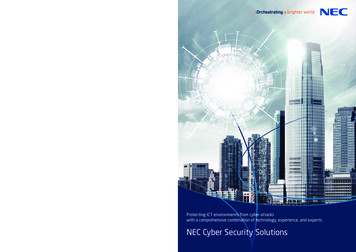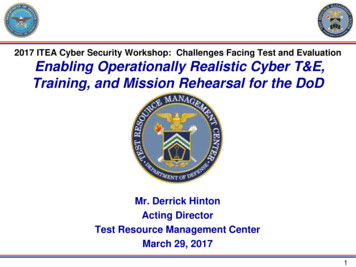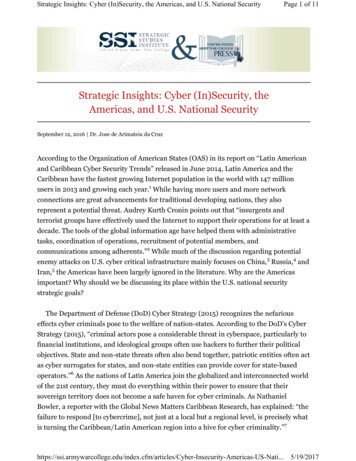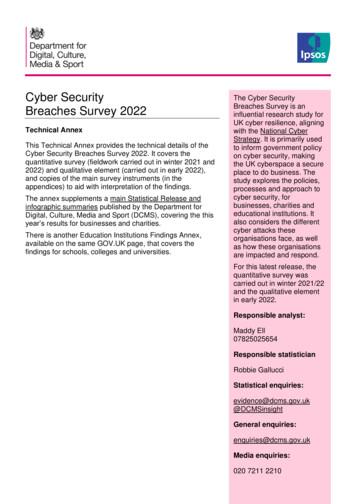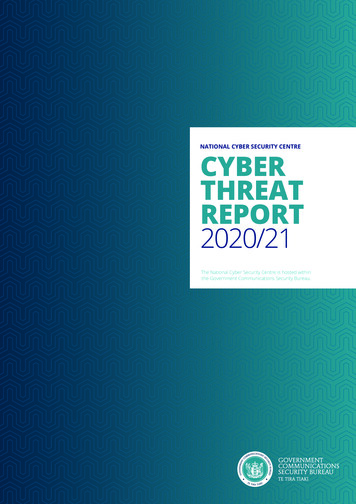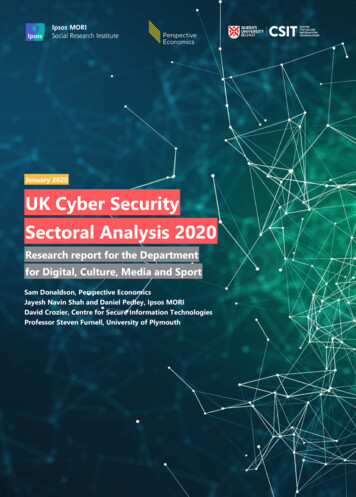
Transcription
TLP:WHITECyber Security Threat Trends 2020-M12December 2020With reference to the FIRST Traffic Light Protocol (TLP) standard 1, this document is classifiedas TLP:WHITE information. Recipients may share with peers and partner organisationswithout restriction.Cyber Security Threat Landscape of the past 12 months (source: GovCERT.HK)Trending: Distributed Denial of Service (DDoS) attack continues causing adverse impact to organisations'networks and operations. Organisations should endeavour to protect their critical services by adopting appropriate anti-DDoS measures.Supply chain attack can lead to serious damage to organisations such as data theft or serviceinterruption. Organisations should assure a defence-in-depth strategy and proper privilegedaccess management with least privilege enforcement are in place for their systems and networks.Phishing continuously evolves with new attack tactics and phishing themes. Organisations couldimplement advanced threat detection and protection technology to protect against the threat.Security awareness training should be provided regularly to refresh end users with defencetechniques on newly emerging phishing tactics.1https://www.first.org/tlp/Cyber Security Threat Trends 2020-M12P.1
TLP:WHITECERT Advisories Cyber attack targeted SolarWinds Orion PlatformGovCERT.HK 2 , HKCERT 3 , SingCERT 4 , CERT NZ 5 , Australian Cyber Security Centre (ACSC) 6 ,Cybersecurity and Infrastructure Security Agency (CISA)7, National Cyber Security Centre (NCSC)8,Canadian Centre for Cyber Security 9 issued alerts reminding organisations and systemadministrators to patch SolarWinds Orion Platform which was exploited actively in a globalintrusion campaign. The affected versions were 2019.4 HF 5, 2020.2 with no hotfix installed or2020.2 HF 1. System administrators should patch their affected products immediately. If forany reasons the patch could not be applied immediately, system administrators should disconnector completely shut down SolarWinds Orion products. System administrator should also refer toproduct vendor's advisory and mitigation measures. Red Team security assessment tools were stolen in security breachACSC10, CISA11 and Canadian Centre for Cyber Security12 issued alerts regarding security breachincident of FireEye, in which the company's Red Team tools were stolen by threat actor. The toolscould be abused by threat actor to gain unauthorised access or even take control of targetedsystems. The stolen tools did not contain zero-day exploits. FireEye released countermeasuresfor detection on the use of the stolen tools. Security events in Hong Kong dropped in Q3 2020HKCERT 13 released its Hong Kong Security Watch Report (Q3 2020). The number of securityevents declined from 13,365 in Q2 2020 to 6,753 in Q3 2020, contributed by the drop in malwarehosting, phishing, defacement and botnet events. There were 934 malware hosting events, 552phishing events, 571 defacement events and 4,696 botnet events in Q3 2020, recorded a decreasefrom Q2 2020 by 88%, 70%, 46% and 21% respectively. There was no Botnet Command andControl Centre (C&C) security event for four consecutive quarters. Mirai was the most numerousbotnet family though it dropped 28% in Q3 ert/en/alerts detail.xhtml?id 535https://www.hkcert.org/my url/en/alert/201215014 5 loited/6 rts/potential-solarwinds-orion-compromise7 0/12/13/active-exploitation-solarwinds-software8 solarwinds-orion-compromise9 ity-incident10 s/theft-fireeye-red-team-tools11 0/12/08/theft-fireeye-red-team-tools12 -incident13 https://www.hkcert.org/my url/en/blog/201207013Cyber Security Threat Trends 2020-M12P.2
TLP:WHITECERT Advisories Apply patch to address vulnerability in FortiOSHKCERT14, 15 and CERT NZ16 issued alerts reminding organisations and system administrators topatch Fortinet's FortiOS software. Vulnerability CVE-2018-13379 was published in 2019 which,when exploited, could allow an attacker to steal SSL VPN credentials. FortiOS versions 6.0.0 to6.0.4, 5.6.3 to 5.6.7 and 5.4.6 to 5.4.12 were affected. About 1,000 Hong Kong IP addressesmight be vulnerable to CVE-2018-13379. System administrators should patch their affectedproducts immediately. Exploitations against vulnerability in VMware productsCISA17, 18 and Canadian Centre for Cyber Security19 issued alerts stating that threat actors activelyexploited a command injection vulnerability, CVE-2020-4006, in VMware Workspace One Access,Access Connector, Identity Manager, and Identity Manager Connector. System administratorsshould apply software patches timely and monitor any suspicious connections to theadministrative configurator on port 8443. End of support for Adobe Flash PlayerHKCERT20 published an article to remind users that Adobe Flash Player was no longer supportedafter 31 December 2020 and Flash content was blocked from running in Flash Player from12 January 2021. Users should uninstall Adobe Flash Player from their devices and update theweb browsers to latest version. Web developers could adopt open standards such as HTML5,WebAssembly and WebGL, etc.14151617181920https://www.hkcert.org/my url/en/blog/20120801https://www.hkcert.org/my g/my url/en/blog/20121601Cyber Security Threat Trends 2020-M12P.3
TLP:WHITEIndustry Insight on Cyber Security Threat TrendsAlmost 77% of Distributed Denial of Service (DDoS) attacks in Q3 2020 targeted online gambling andonline gaming industriesNexusguard published the “DDoS Threat Report 2020 Q3”21, which included the analysis result andobservation on DDoS attacks detected in the third quarter of 2020. The key findings were: In Q3 2020, there were less than 40,000 DDoS attacks recorded, a decrease of 51.28% fromQ2 2020, and was the lowest volume among the first three quarters of 2020. UDP Attack(30.11%) and DNS Amplification Attack (22.22%) were the most prominent attack vectors,recorded a decrease of about 78% and 12.9% from Q2 2020 respectively. However, TCPSYN Attack (20.66%), the third most common attack vector, had an increase of more than470% since Q2 2020. In terms of application attack source distribution, Hong Kong rankedthe fourth (6.54%) worldwide and ranked the second (10.45%) in Asia-Pacific region. The majority (over 72%) of DDoS attacks was single-vector. The highest number of attackvector recorded in the period was 13. Over 93% of the detected DDoS attacks had attacksizes less than 1 Gbps. The largest attack size was 71.7 Gbps, roughly halved against Q22020 and diminished by almost 75% from Q3 2019. The average attack size was 0.55 Gbps,63.78% lower than Q2 2020. Most of the DDoS attacks (72.76%) lasted less than 90 minutes. The average duration ofattacks was 137.57 minutes, grew by 30.81% from Q2 2020 and 42.90% from Q3 2019. Thelongest attack continued for more than 575 hours, dropped by 45.81% compared to Q2 2020but rose by 12.65% from Q3 2019. 44 Autonomous System Numbers (ASNs) were targeted by sophisticated bit-and-pieceattacks in Q3 2020. The attacks injected small pieces of junk traffic across a wide pool of IPaddresses to evade detection, but the accumulated junk traffic were significantly large tocause adverse impact to the targets. In Q3 2020, more than 45% of DDoS attacks targeted online gambling industry and almost32% targeted online gaming industry.The largest attack size recorded in Q3 2020 foronline gambling industry and online gaming industry were 57.4 Gbps and 23.57 Gbpsrespectively.Adoption of network segregation, resource compartmentalisation and securecoding practice; formulation and periodic drilling of incident response plan; and engagingthird party DDoS mitigation services were recommended measures to protect against DDoSattack.Source: ort/ddos-threat-report-2020-q3Cyber Security Threat Trends 2020-M12P.4
TLP:WHITEIndustry Insight on Cyber Security Threat TrendsAttackers adapted new tactics quickly in conducting spear-phishingBarracuda published the "Spear Phishing: Top Threats and Trends”22, which included the analysis ofover 2.3 million spear-phishing attacks during August 2020 to October 2020 and the trends of socialengineering attacks. The key findings were: 50% of the analysed attacks were phishing, followed by scamming (36%) and business emailcompromise (12%). Business email compromise (BEC) increased from 7% in March 2019 to12%. Extortion dropped from 11% in 2019 to 2% of all analysed spear-phishing attacks dueto a slower growth than other types of spear-phishing attacks. 13% of all spear-phishing attacks emails were sent from potentially compromised internalemail accounts. This type of attack was dangerous since the emails were sent fromlegitimate email accounts which were more likely to be trusted. Moreover, the attacks didnot only targeted users within the same organisation of the compromised accounts. 85% ofphishing emails from these compromised accounts were sent to recipients with different emaildomains. Organisations should improve their detection and remediation mechanism oncompromised accounts and train their employees to increase the awareness on suspiciousmessages from compromised accounts. Malicious URLs were found in 71% of spear-phishing attacks. 71% of the malicious URLsused ".com" as domain, but attackers also customised the malicious URLs for different targets.For example, ".edu" domain was commonly used in spear-phishing attacks to education sectortargets. 4% of spear-phishing attacks used URL redirection or URL shortening for detectionevasion since those domains were more likely to be permitted by security solutions. 64% ofanalysed attacks with shortened URLs used "t.co", link shortening service from Twitter. Attackers continued to leverage COVID-19 in spear-phishing attacks although the growth inoverall volume was not significant since March 2020. 72% of COVID-19 themed spearphishing attacks during June to October 2020 were scamming attacks on fake cures anddonations. Organisations could consider implementing detection and protection technology which couldanalyse normal communication patterns and detect abnormal email conversations andcompromised accounts to tackle attackers' evolving evasion tactics on bypassing gateways andspam filters. Domain-based Message Authentication, Reporting and Conformance (DMARC)could be adopted for prevention of domain spoofing and brand hijacking.Source: g-report-5?utm source 42964&utm medium blogCyber Security Threat Trends 2020-M12P.5
TLP:WHITEIndustry Insight on Cyber Security Threat TrendsNetwork attacks and scams skyrocketed in Q3 2020WatchGuard collected anonymised information on threat detected from 47,866 globally deployedappliances and summarised the latest malware and exploit trends observed from the collected threatdata in its "Internet Security Report – Q3 2020"23. The highlights from the report included: Both network attacks and unique attack signatures recorded two-years high with over 3.3million attack attempts and 438 signatures respectively in Q3 2020. Compared to Q2 2020,network attack volume increased 90%. The Asia Pacific region (APAC) got 11% growth inglobal share in terms of attack volume, from 18% in Q2 2020 to 29% in Q3 2020. The globalshare for Americas region (AMER) and Europe and Middle East region (EMEA) were 49% and22% respectively. System administrators should keep the systems up-to-date with latestpatches and adopt advanced network intrusion prevention service. Network attacks targeted an authentication bypass vulnerability of a supervisory controland data acquisition (SCADA) control system (CVE-2016-4510) were detected in differentnetworks worldwide, making this threat one of the most-widespread network attacks in Q32020. Attackers targeted almost 46% of networks in AMER for this vulnerability. Othermost-widespread network attacks in Q3 2020 included two SQL injection attacks and twocross-site scripting attacks. High prevalence of COVID-19 scams was observed in Q3 2020. Malicious web sites relatedto a COVID-19 adware campaign and a phishing attack abusing Microsoft SharePoint to host apseudo-login page impersonating the United Nations debuted in the lists of top 10compromised websites and top 10 phishing domains in Q3 2020.In average, 262 malwaredomains, 71 compromised websites, and 52 phishing campaigns were blocked perorganisation. Organisation-wide awareness training on new phishing techniques should beprioritised to defend against attacks via phishing emails and malicious websites. Over half of detected malware in Q3 2020 was zero day malware, a 64% decrease comparedto Q2 2020. Nevertheless, these malware samples changed frequently and were more likelyto evade from detection by signature-based anti-malware solutions. Organisations couldconsider implementation of multi-layered anti-malware defence. Almost 54% of detectedmalware were distributed via encrypted communication channels (TLS/HTTPS).Allencrypted traffic should be inspected as far as possible to ferret out hidden malware.Source: ce-center/security-report-q3-2020Cyber Security Threat Trends 2020-M12P.6
TLP:WHITESummary of Microsoft December 2020 Security Updates7125Product FamilyImpact24SeverityImportant orbelowbelowAssociated KB and / or Support WebpagesWindows 10RemoteCriticalKB4592438, KB4592440, KB4592446,CodeExecution KB4592449, KB4592464, KB4593226Windows Server 2016,2019 and Server CoreinstallationsRemoteCodeExecutionCritical KB4586781, KB4586786, KB4586793,KB4586830, KB4592438, KB4592440,KB4592449, KB4593226Microsoft EdgeRemoteCodeExecutionCritical KB4592438, KB4592440, KB4592449RemoteCodeCritical KB4595459, KB4595462, KB4583556Dynamics 365 for Finance and Operations:Product Familieswith PatchesMicrosoft DynamicsCriticalExecutionMicrosoft ExchangeServerRelease NotesRemoteCodeExecutionCritical KB4593465, KB4593466, KB4593467RemoteCriticalKB4486696, KB4486697, KB4486721,related softwareCodeExecution KB4486751, KB4486752, KB4486753,KB4493138, KB4493149ChakraCoreRemoteCodeExecutionCritical Release NotesWindows 8.1 andWindows Server 2012,2012 R2RemoteCodeExecutionImportant KB4592468, KB4592484, KB4592495,KB4592497RemoteCodeImportant KB4486698, KB4486757, KB4493140Microsoft Excel: KB4486754, KB4493139,Microsoft SharePoint-Microsoft Office-relatedsoftwareExecution24KB4493148The Impact and Severity are the maximum impact and severity assessment of the vulnerabilities in the associatedknowledgebase (KB) by Microsoft.Cyber Security Threat Trends 2020-M12P.7
Product FamilyImpact24SeverityTLP:WHITEAssociated KB and / or Support WebpagesMicrosoft Outlook: KB4486732, KB4486742,KB4486748Microsoft PowerPoint: KB4484372,KB4484393, KB4484468Microsoft Office Online Server: KB4486750Microsoft Office Web Apps: KB4486704,KB4486760Microsoft Office 2019: Click to RunMicrosoft 365 Apps for Enterprise: Click toRunMicrosoft Visual StudioRemoteCodeExecutionImportant Microsoft Visual Studio 2017 version 15.9:Release NotesMicrosoft Visual Studio 2019 version 16.0:Release NotesMicrosoft Visual Studio 2019 version 16.4:Release NotesMicrosoft Visual Studio 2019 version 16.7:Release NotesMicrosoft Visual Studio 2019 version 16.8:Release NotesVisual Studio Code TS-Lint Extension:Release NotesVisual Studio Code Language Support forJava Extension: Release NotesVisual Studio Code Remote - SSH Extension:Release NotesAzureSecurityFeatureImportant BypassTeam Foundation ServerSpoofingCyber Security Threat Trends 2020-M12Azure SDK for Java: Release NotesAzure DevOps Server 2019 Update 1.1:Release Notes, Release NotesAzure DevOps Server 2019 Update 0.1:Release NotesAzure DevOps Server 2020: Release NotesC SDK for Azure IoT: Release NotesImportant Team Foundation Server 2015 Update 4.2:Release NotesTeam Foundation Server 2017 Update 3.1:Release NotesP.8
Product FamilyImpact24SeverityTLP:WHITEAssociated KB and / or Support WebpagesTeam Foundation Server 2018 Update 1.2:Release NotesTeam Foundation Server 2018 Update 3.2:Release NotesLearn more:Security Alert (A20-12-01): Multiple Vulnerabilities in Microsoft Products (December ert/en/alerts detail.xhtml?id 531)Sources: Microsoft December 2020 Security leaseNote/2020-Dec)Data analytics powered byCyber Security Threat Trends 2020-M12in collaboration withP.9
TLP:WHITE Cyber Security Threat Trends 2020-M12 P. 2 CERT Advisories Cyber attack targeted SolarWinds Orion Platform GovCERT.HK2, HKCERT 3, SingCERT 4, CERT NZ 5, Australian Cyber Security Centre (ACSC) 6, Cybersecurity and Infrastructure Security Agency (CISA)7, National Cyber Security Centre (NCSC)8, Canadian Centre for Cyber Security 9 issued alerts reminding organisations and system




